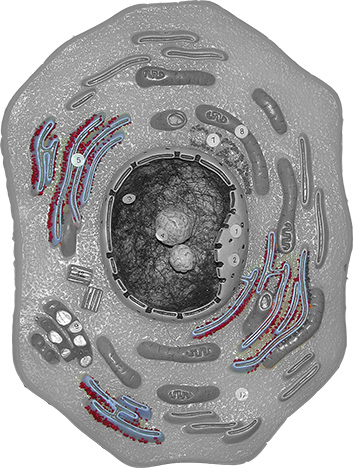Endoplasmic Reticulum
|
|
The endoplasmic reticulum (ER) is the most extensive membrane system in cells. In some cells the ER makes up over 40 % of the cells internal membrane structures. The ER in continuous with the nuclear membrane, stretches throughout the cytoplasm and merges with the plasma membrane. Because of this, the ER is thought to be a major transport mechanism in the cell. Molecules could literally leave the nucleus and travel through the ER to the outside environment. The ER consists of membranous hollow tubules. The inside of the tubules is called the cistern (cisternae pl.). The tubules have pores that allow proteins produced by ribosomes on the surface of the ER to move into the cisternae and to be transported out of the cell.
Microscopically, the ER can appear either as a smooth membrane or as a bumpy, rough membrane. The rough membrane is called rough endoplasmic reticulum. It appears rough because ribosomes are attached to it. Ribosomes can attach and detach at will from the surface of the ER. In the image to the right the rough ER is indicated as the blue, flat membrane structures. The red dots on the surface of the membranes are the ribosomes. The smooth ER is present but not color delineated.
The rough ER is responsible for protein production. Cells, like the pancreatic acini cells that produce digestive enzymes which are secreted into the intestine contain large amounts of rough endoplasmic reticulum (RER). The smooth endoplasmic reticulum is associated with cells that have high lipid production/metabolism, steroidal hormone production and are active in detoxification.




